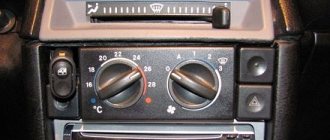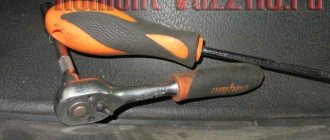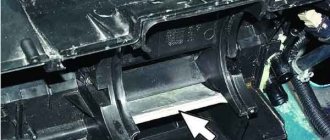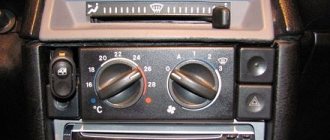During the cold season, many Zhiguli owners are interested in ensuring that the heater is in good condition. However, what to do and what to do if the VAZ-2112 heater damper does not work? Is it possible to correct the current situation on my own? What could be the cause of a car heater malfunction?
If you properly care for your car and carry out periodic preventative maintenance, expensive repairs will cost a pretty penny.
Restoring the functionality of the heater damper on a VAZ-2112
During the cold season, many Zhiguli owners are interested in ensuring that the heater is in good condition.
However, what to do and what to do if the VAZ-2112 heater damper does not work? Is it possible to correct the current situation on my own? What could be the cause of a car heater malfunction? If you properly care for your car and carry out periodic preventative maintenance, expensive repairs will cost a pretty penny.
The main reasons for the inoperability of the VAZ-2112 stove
Before carrying out repairs, it is extremely important to ensure a successful diagnosis. Here are the reasons for this problem:
- lack of ability to adjust the temperature;
- the stove cannot change the heating speed;
- breakdown of elements that should distribute warm air flows throughout the car interior;
- violations in the temperature sensor installed on the ceiling;
- malfunction of the ACS controller;
- Antifreeze leak.
Carrying out diagnostic measures will allow you to understand what the problem is and how it can be successfully eliminated.
How is diagnosis carried out?
Before repairing the damper, it is extremely important to carry out diagnostics. What subtasks need to be completed?
Checking the temperature sensor
To check, it is recommended to remove the ends of the temperature sensor located on the ceiling of the car and apply a voltage of 1.2 V. In this case, it is advisable to apply the voltage to the plus and minus terminals. Then set the controller in two positions: min (blue dot), max (red). In this case, the fan should not rotate.
Checking the serviceability of the ACS controller
For diagnostics, use a multimeter that measures the voltage on the pink and brown wires. In this case, turn on the ignition and start turning the temperature sensor knob. It should be noted that if there are problems with the controller, the heater damper may not work. Despite this, additional checks are recommended.
Heater damper
The stove includes 2 dampers:
- the upper device is used to adjust the cold air intake;
- the lower device must control the flow of hot air flow from the heater radiator.
If the drive mechanism or damper breaks down, the heater begins to heat weakly. It may also fry too much or not provide even the slightest bit of heat.
And here’s what the malfunction of the damper of the stove in use may be:
- biting the device;
- jamming;
- drive failure;
- device distortion;
- jamming due to rust.
It should be noted that metal stove dampers can jam due to rust. At the same time, plastic models often warp due to hot air.
Checking the micro gearbox
An ohmmeter is traditionally used for this diagnosis. First, it is recommended to set the degrees to the minimum value and wait about 15 seconds, then disconnect the controller connector and, with the motor running, measure the resistance between contacts X1.4 and X1.1. In this case, the heater damper of the VAZ-2112 should show 3.2–5 kOhm. If a breakdown of the micro-reducer is detected, the car heater will have to be disassembled.
Problem: heating speed does not change
This malfunction may be due to one of the following:
- the stove operates only in the third mode;
- The device operates only in the first two modes.
The main task is to successfully find the location of the resistance resistor. However, in any case, repairs will still need to be carried out.
resistance resistor
Another possible breakdown is in the resistance resistor, and any car heater has two resistance spirals. If both spirals operate successfully, the electric motor of the heating equipment will operate at first speed. If the resistor operates on the first spiral, only the second speed becomes available. The third speed is the maximum and does not include the inclusion of a resistor. Because of this, it is extremely important to pay attention to the ohm resistor and understand what the problem is.
Repair features
So, how should you repair your stove damper? First of all, you need to disassemble the damper and then replace it.
Disassembly stages
Knowing where the heater damper is located on a VAZ-2112, and having carefully read the vehicle’s instructions, you can understand what steps you should go through:
- The existing liquid, which is to be used for cooling, is first poured out completely.
- Disconnecting the car battery by disconnecting the minus terminal.
- Removing facing materials, windshield trim and soundproofing upholstery.
- Removing the fan that is installed inside the stove.
- Disconnecting the clamp that is part of the vacuum hose.
- Removing the heater air intake housing. These actions are sensitive and time consuming. If you first remove the dashboard, you can understand how to get to the VAZ-2112 heater damper in the shortest possible time.
- The next step is to remove all the parts used to attach the radiator.
- After this, the rear heater casing is disconnected.
- The radiator is pulled out of the heater.
- Now you can change the part itself. After a successful replacement, the problem associated with the fact that the heater damper on the VAZ-2112 does not work is successfully resolved.
Knowing how to remove the heater damper, you should ensure that reassembly is carried out correctly.
Assembly steps
The new part must be installed in a special way: the fork on its axis must be reliably engaged with the lever. This requires an open damper mechanism, so it is best to leave it raised. Otherwise, the element will not be able to open according to the optimal pattern and the stove will still not work. Only correct installation guarantees that the heater will function successfully.
If you are interested in how to change the VAZ-2112 heater damper, you should understand that everything will be done in the reverse order.
At the end of the procedure, it is mandatory to fill in the coolant and check the functionality of the part, the tightness of the hose structure and all connections. Then you need to turn on the heater and monitor it carefully.
Only if there is no such problem as the damper of the VAZ-2112 stove does not open, can you remain satisfied with the result of replacing the equipment.
Source
The stove doesn't work at all
In this case, some node of the system has broken down. All components of the structure must be checked. But, as practice shows, the fan is to blame. If everything is fine with it, next check the thermostat.
After checking all components and determining the malfunction, consider carrying out a major overhaul of the stove. Having repaired the system once, you will be able to drive comfortably for a long time without all sorts of surprises.
Heater damper drive VAZ 2112
On the VAZ 10th family, which includes the VAZ 2110-2112 models, the designers used an electronically controlled interior heating system, thanks to which the temperature set by the driver is maintained automatically.
On the VAZ-2110, instead of a manual heater control mechanism with a cable drive of the main elements - the coolant shut-off valve and dampers, an automatic heater control system (AHC) controller with a temperature sensor and a gearmotor that regulates the position of the dampers are used.
In such a stove, the valve for shutting off the antifreeze supply is no longer used, and the adjustment of the heater operating mode - “heating” or “ventilation” - is carried out by a central damper, which directs the air flow through the radiator or bypassing it.
Stove design
This unit includes several devices. The radiator is the main element of the stove - it heats the air entering the cabin. It is located under the hood. The next component is the air distributor, equipped with special pipes that run through the cabin of the 2110.
If we compare the “ten” with previous models, an important innovation has appeared in its heating system - an evaporator (the diagram includes it in the list). The device is installed in an air conditioning system. Not all owners know about its existence, since it rarely fails.
To control the operation of the heater, an SUAO unit is installed in the VAZ 2110 car, which is called a controller in the technical operating manual. The unit works in conjunction with a temperature sensor in the cabin; it is also called a ceiling sensor. The sensor reports the temperature to the unit, then this indicator is compared with the set temperature on the handle. If the indicators differ by more than 2°, warm or cooled air is supplied to the VAZ 2110 interior.
It’s worth taking a closer look at the handle, or more precisely at its extreme positions – MAX and MIN. If the heater knob is set to one of these indicators, heat is supplied without the operation of the temperature sensor in the cabin. The scheme includes all of the above elements.
The device of the “tens” heater includes another unit - a gearmotor, which is responsible for opening and closing the damper. The miniature electric motor performs an important task in the operation of the heating system, as evidenced by the diagram. If the gearmotor is faulty, the system will only produce cold or hot air. If the gearmotor fails when the damper is closed, the system will stop functioning. We have described the main components of the VAZ 2110 heater; the diagram contains a more detailed list.
Let us highlight the main components of the system:
- Radiator.
- Air distributor.
- SUAO block.
- Ceiling sensor.
- Lever.
- Damper.
- Gearmotor.
Radiator
In the heating system, a radiator is installed for heating, which enters the VAZ 2110. It is also called a heat exchanger. Heating is carried out by the heat of the antifreeze. This component is connected to the engine cooling system by pipes and hoses. Antifreeze constantly circulates through the heat exchanger of the stove. The damper, based on the commands of the unit, directs the incoming air to the radiator or directly into the passenger compartment. If the heater damper is in an intermediate position, then one part passes through the heat exchanger, and the second bypasses the radiator. If we compare this part of the stove with previous generations of the VAZ, it has a number of useful improvements, as the diagram demonstrates.
SUAO and ceiling sensor
These components of the VAZ 2110 heater are connected and operate according to the following principle:
- The sensor determines the temperature inside the car;
- This data is sent to the SUAO block;
- The block compares the temperature with the position set on the handle of the VAZ 2110 stove;
- After comparison, the position of the damper changes or remains the same - it depends on the indicator;
- This way the temperature in the cabin is controlled;
- If the heater handle is set to MAX or MIN, then the data from the ceiling sensor is not taken into account.
All these actions are demonstrated by the diagram. The block is a set of microcircuits; the normal operation of the stove depends on its serviceability. Both the sensor and the control system can be replaced.
see also
Damper and gearmotor
The heater gear motor changes the position of the damper, due to which air is supplied to the cabin. This component is controlled by the control system block. If the device is faulty, the damper will not move. The unit is a miniature electric motor. When it breaks, it is usually replaced, since repairing it will be problematic. This also applies to the damper. The diagram shows the connections between the gearbox and the block.
How malfunctions manifest themselves
The automatic temperature maintenance system used on the VAZ-2110 is more convenient in terms of control, since the automatic control system does everything independently, but is less reliable than a mechanical cable drive. Moreover, problems are caused by the electronic and electrical components of the stove - the controller, temperature sensor and micromotor gearbox, the central damper, which regulates the air supply to the cabin from the outside.
Problems with the operation of the VAZ-2110 heater related to the damper:
- lack of temperature control (only hot or cold air comes from the stove) regardless of the position of the handle on the controller;
- insufficient air heating (even when setting the handle to the maximum temperature);
- squeaks, knocks and extraneous noises after setting the temperature.
The stove blows cold air
If the antifreeze is at operating temperature, the tap is open and the system as a whole is operational, then the reason for the supply of cold air can only be the formation of an air lock in the radiator. This problem is solved as follows:
- The car is placed on any hill so that the front part is higher than the rear axle.
- Open the tap on the radiator.
- Start the engine and let it run for 5 minutes. During this time, periodically press the gas pedal.
- Now we slide down the hill, close the tap and check the heating system.
Features of the design of the VAZ - 2110 stove damper
Note that VAZ-2110 of different years of manufacture uses heaters that differ in design:
1. Old-style stove damper
Old heaters use two central dampers, one of which blocks the flow of air into the cabin from the outside, and the second one redirects the air flow to the heater radiator or bypasses it. They are interconnected by drives and opened by a micromotor gearbox.
2. New sample
In the new type of stove there is only one central damper and it is connected by a drive to the gear motor directly, and not through a lever.
3. Under the “Euro” panel
Structurally, such a stove does not differ from the new type of heater, but in it the damper for distributing the air flow into zones is controlled by another micromotor gearbox.
It is easy to visually distinguish the stoves by the location of the heater fan. In the old-style interior heater, the fan is located horizontally, while in the new model, it is positioned vertically. Their gearmotors are also different.
Old style cooling system
Such heaters were installed on early 21120 models. You can determine the modification of the system by its appearance, after first removing the frill of the car.
To replace the radiator you need:
- Carry out steps 1, 4-7 for removing the new type cooling system.
- We dismantle the expansion tank of the cooling system.
- We remove the vacuum booster by unscrewing the 2 nuts (17 mm) and carefully (without damaging the brake system pipes) move the brake master cylinder to the side. Remove the vacuum booster pipe.
- Inside the car, unscrew the 4 nuts from the brake pedal studs and, together with the pedal, remove the car's amplifier.
- Thus, we gained access to the heater core, which is secured with three screws. We replace it and reassemble the entire system in the reverse order.
Causes of malfunctions
Depending on the design of the stove, the damper may cause a disruption in the efficient operation of the heater for the following reasons:
- deformation;
- wear of seals;
- deterioration or damage to control levers and rods;
- skew.
Deformation is a problem with old-style heaters. The first dampers of the VAZ-2110 stove were equipped with plastic elements that bent under the influence of temperature. Because of this, even when completely closed, cold air from outside leaks in and mixes with the heated air, and the efficiency of the stove decreases. Subsequently, the designers replaced the plastic flaps with aluminum ones and the problem with deformation disappeared.
To ensure tightness, the dampers have seals that reduce air leakage. Initially, foam rubber seals were used, which quickly wore out and became damaged. Later, foam rubber was replaced with rubber, but this only extended the service life of the seal; over time, the rubber ages, cracks and collapses.
On old-style stoves, rods and levers may break. On new heaters, there is another problem - wear on the edges of the square end of the gearbox, with which it is inserted into the groove made in the damper axis. As a result, the limit switch bypasses the groove, and the heater damper jams, although the gearmotor operates. The misalignment occurs due to the displacement of the damper axis in the mounting holes of the housing. Because of this, the damper warps and jams when opening.
Diagnosis of the problem
If the reason why the VAZ-2110 stove does not work is the damper, it is not difficult to identify it. To do this, disassemble the central deflector, turn on the ignition and rotate the temperature setting knob to its extreme positions. In a working stove, the central damper will not knock and will completely open and close the air supply channel.
If the heater damper does not move or stops in a position that does not completely block the air passage, it may be stuck. You can verify this by pushing the valve with your hand or a long rod. If after this the damper returns to its normal position, then this is the reason why it is jammed. Through the mounting hole of the deflector, you can assess the condition of the damper and its seals. If the damper is deformed, its bend is clearly visible.
Repair and restoration of the stove damper
The deformed heater damper of the VAZ-2110 cannot be repaired; it only needs to be replaced. In this case, it is better to purchase a replacement metal part that is not so susceptible to temperature effects.
Whatever heater is installed on the VAZ-2110, to carry out repair work, the heater must be completely disassembled. In this case, the process of dismantling and disassembling depends on the design of the stove.
A positive aspect of the heater design on the VAZ - 2101 is its location - to get to it and the dampers you can from the engine compartment and you don’t have to remove the front panel.
Disassembling an old-style stove
For example, let's look at how to disassemble an old-style heater:
- Remove the terminal from the battery.
- We remove the windshield wipers, the seal, remove the air intake near the windshield (“jabot”) from the car, in the process you will need to disconnect the windshield washer nozzle tubes.
- We dismantle the insulation that separates the stove body from the engine compartment.
- We remove the gear motor.
- We divide the housing of the stove and air filter into two halves. To do this, unscrew the coupling bolts around the perimeter of the housings and remove the mounting brackets.
- Disconnect the fan power wires.
- Remove the outer half of the air filter and heater housing (along with the fan).
- We dismantle the inner part of the fan housing.
After this you will have access to the dampers. If you are only planning to repair or replace the heater dampers, there is no need to drain the antifreeze, since the heater radiator will remain in place and will not be removed.
Before removing the dampers, carefully inspect and remember their position and the way they are engaged. Further actions depend on the nature of the damage. Deformed damper parts cannot be repaired and only need to be replaced. As for damaged rods and levers, try to repair them or simply replace them. The damaged seal is replaced.
When assembling the stove, pay special attention to the engagement of the dampers. Do it as it was before disassembly, otherwise the dampers will not work correctly, which will affect the performance of the heater.
Disassembly and repair of a new type heater
The new model stoves are disassembled differently:
- disconnect the battery terminal, drain the antifreeze;
- dismantle the frill and insulation;
- disconnect the power wires of the fan and micromotor gearbox;
- unscrew the fasteners that secure the stove body to the body;
- disconnect the coolant supply pipes to the heater radiator;
- We remove the heater from the car along with the filter housing.
After this, we disassemble the stove body, dividing it into two halves, after first disconnecting the air filter housing and removing the mounting brackets. Next, we change or repair the damper, assemble the heater and install it on the car.
Note that the general algorithms of work are indicated above, but in reality, dismantling the stove is not so easy, since many fasteners are located in hard-to-reach places, sometimes you have to disconnect or remove elements that make it difficult or interfering with the removal of the unit.
Video: Why the VAZ 2110 stove does not heat up. Modification of the damper.
The decision to replace the heater damper drive with convenient automatic control appeared almost simultaneously with the release of the 2110 VAZ model. A variety of methods have been proposed and tested. But it has not yet been possible to choose the final result. As a result, the automatic heater damper on the VAZ-2110 is installed in various ways.
When making an electric drive for the stove damper, you should take into account the following nuances:
– what type of automatic control system is installed, since this affects the connection diagram; – decide which micromotor gearbox (MMR) is installed on the heater (if this MMR was produced before 2005, then it needs to be improved).
Options for upgrading the heater damper to automatic adjustment:
1. Use a standard gearmotor from a VAZ-2110 model car. 2. Use the stepper electric damper drive from the VAZ 2170 (Lada Priora).
Dismantling
When the work to restore the functionality of the MMR is completed, install it in place. For this:
- Insert the pin of the micromotor-reducer lever into the slot of the lever. It is located on the damper drive;
- If the lever is not turned properly, apply 12V voltage to the motor connector pins using two wires. We are talking about yellow wires here. This way you can return the lever to the correct position;
- Having installed the micromotor-reducer, check it for operability, plus watch how the damper drive of your heater moves, whether the heater control lever “plows” properly to regulate the temperature.
We will repair or replace the damper and heater drive, you will be able to return the heater to its previous functionality and independently determine what temperature regime will be set inside the cabin of your VAZ 2110.
Principles of interior ventilation
Before you understand the causes of the malfunction, you should know the principle of the device and the rules by which ventilation is carried out. So:
- Air is supplied to the passenger compartment through the holes in the trim on the windshield : when the car is moving voluntarily, or forcibly with the help of a heater fan.
- Air escapes through the gaps between the inner door panels and between the upholstery, then through the holes located at the ends of the doors. The thermal insulation of the interior is improved by valves built into the openings, which allow air to pass out and prevent it from entering the inside of the car.
- The main part of the air is directed to the windshield; flows are directed to the central part and side windows through deflectors blocked by flaps.
- Air is supplied to the driver’s feet and the passenger sitting next to him through two pairs of deflectors: one pair is located near the floor, the other at knee level.
- Through a lining located on the floor tunnel and two air ducts built under the front seats, air is supplied to the feet of passengers in the rear.
- To prevent the entry of outside air, especially if the road section is polluted, smoky or very dusty, there is an air recirculation system. When the recirculation button is recessed on the instrument panel, the electro-pneumatic valve opens. In this case, under the influence of the vacuum that occurs in the intake pipe, the access of outside air is blocked by the recirculation system flap into the vehicle interior.
- The air temperature is regulated by the controller handle from 16°C to 30°C.
- Information about the temperature is read from its sensor by a unit with a microfan located on the ceiling. The unit turns on the micromotor when a temperature difference occurs, which controls the heater dampers. When the damper reaches the desired position, a signal is sent from the sensor to the control unit, which turns off the micromotor.
New cooling system
The sequence of your actions in this case is as follows:
- First of all, for safety reasons, disconnect the negative terminal of the battery. We drain the cooled antifreeze or antifreeze, first opening the expander cap. To drain the liquid you will need a container with a volume of 4-5 liters.
- Now, after unscrewing the two nuts, remove the wipers from the car.
- Then we dismantle the released protective plastic cover under the windshield, which is secured with 2 nuts and 4 self-tapping screws.
- To access the stove, remove the frill of the car by unscrewing 5 self-tapping screws, 1 screw and 2 nuts located at the bottom, in the middle of the frill, in the area of the steering rack.
- In order to remove the stove, remove the yellow cross brace, if any, as well as the curved bellows of the air filter.
- We pull the chokes off the radiator pipes.
- Then disconnect all electrical wires from the stove terminals.
- At the steering rack, unscrew 2 nuts that secure the heater, 1 nut securing the heater to the body.
- We unscrew the 3 screws connecting the two halves of the stove.
- We take it out by swinging the right side of the stove, first moving it to the right.
- The radiator in the removed half of the stove is secured with 3 screws. We take it out and replace it with a new one, not forgetting to put on the foam seal. We check the operation of the fan and, if necessary, repair it or replace it with a new one.
- Before installing the assembly, it is advisable to rinse the coolant supply hoses with running water.
- Assembly is carried out in reverse order.
Malfunctions in the heating system of the VAZ 2110 and methods for eliminating them
If a control unit, a temperature sensor with a microfan, a micromotor, or a heater damper position sensor fails, it is best to replace it with new ones, otherwise the cost of repairing the vehicle may become significantly higher if it continues to be used with faulty components. If the moving damper makes a characteristic sound that can be heard in the cabin, and the air does not warm up, then the damper or its drive is damaged . In this case, it is necessary to replace the heater damper of the VAZ 2110 or replace the heater damper drive of the VAZ 2110.
Replacing the damper in the heating system of a VAZ 2110
Replacing the damper in the VAZ 2110 heater is carried out in the following cases:
- Exit from the working state.
- Constant jamming. This happens when the valve is skewed or damaged by corrosion. In this case, the heater does not need to be disassembled. Simply remove the centrally mounted deflector and manually activate the damper.
On a VAZ 2110 car, dampers can be installed of an old or new type. The old one is made of plastic with foam insulation, the new one is metal with a rubber seal.
Advice: If it is necessary to replace the heater damper of a VAZ 2112, it is better to use metal devices of a new type.
Removing the heater damper VAZ 2110
- Drain the liquid from the cooling system.
- The “-” wire is disconnected from the battery terminal.
- The trim, the frame trim on the windshield and the sound insulation upholstery are removed.
- The heater fan is removed.
- The vacuum hose clamp is disconnected from the heater body.
- Remove the three spring clips that secure the front heater air intake housing.
Tip: to make it easier to unscrew and tighten the screws securing the air collector, you can remove the instrument panel, unscrew the screws securing the heater and lift it.
- Remove the screws securing the front housing.
- The front housing is removed.
- The radiator is freed from all hoses.
- The rear heater casing is removed.
- The radiator is removed from the heater.
- A new damper is installed so that the fork located on the damper axis is engaged with the lever.
- The damper must be in the raised position.
- The heater is reassembled in the reverse order of disassembly.
- Coolant is being added.
- The tightness of all connections and hoses, the operation of the dampers, and the entire heater are checked.
How the heater damper is replaced on a VAZ 2110 can be clearly seen in the video; the heater damper is replaced in a similar way on a VAZ 2112 model car.
Replacing the heater gear motor
To perform this procedure, you will need wrenches and a shaped screwdriver. Installing a new part is not very difficult, so a novice car enthusiast can easily handle it in a personal garage.
Replacement procedure:
- remove the windshield wipers, unscrew the locknut and release the frill;
- Now we have free access to self-tapping screws;
- At this stage, you need to remove the rubber seal from the electric motor compartment. To do this, you need to unscrew the nuts on both sides of the frill;
- the damper pipeline must be disconnected so that it does not interfere;
- Unscrew the screws holding the gearbox thermal radiators;
- near the vacuum brake booster in the left niche of the gearbox compartment there is a motor that must be removed by unscrewing the screw securing it from below;
- The damper is assembled in the reverse order immediately after installing the heater gearmotor.
Testing the functionality of the installed element is carried out by measuring the resistance on contacts X1.1 and X1.4 with the controller turned off and the left regulator set to the blue mark position. If there is no resistance or remains constant during the test, this indicates a faulty shaft position sensor. Unfortunately, it is not sold separately, so you will have to change the gear motor.
Adjusting the heater dampers
By adjusting the dampers with your own hands, you eliminate the supply of part of the air “to the glass” when the lever that controls the air flow is installed in the heater in the “chest” or “legs” position. The photo shows the damper adjustment control units.
Adjustment unit with control lever positioned vertically
2 – adjustable rod for installing the damper “in the chest” – “in the legs” 3 – fastening the rod “in the chest” – “on the glass”. To do this, you need to shorten the adjustable rod by three divisions, and use side cutters to bite off the protruding tip on it. After performing such operations, the heater damper will be in the desired position, and the heat from the stove will flow better in the given direction.











